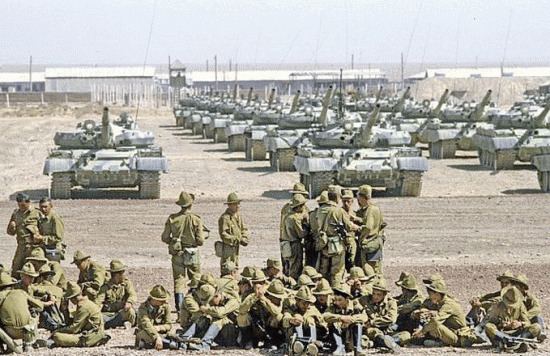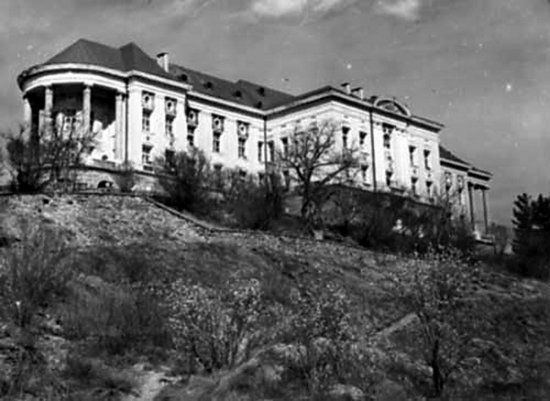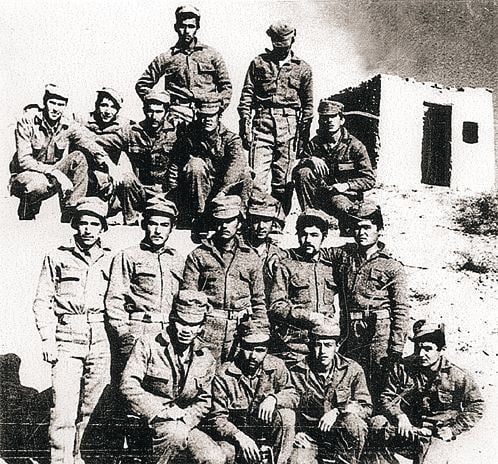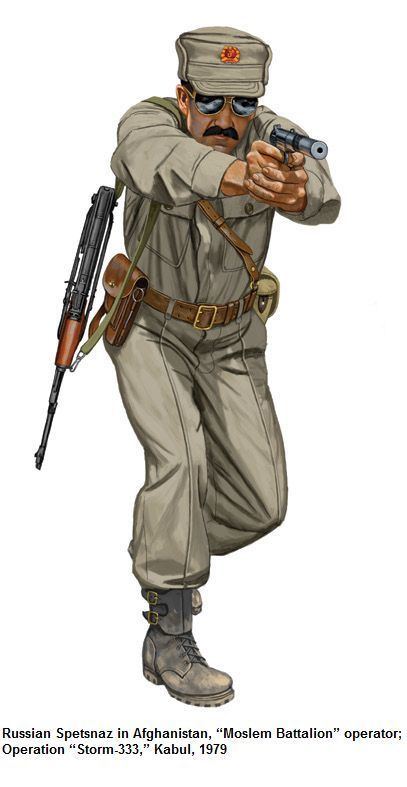Date 27 December 1979 | ||
 | ||
Similar Soviet–Afghan War, Saur Revolution, Soviet withdrawal from Afgh, Operation Magistral, Panjshir offensives | ||
Operation Storm-333 (Шторм-333, Shtorm-333) was an operation that took place on 27 December 1979, in which Soviet Union forces stormed the Tajbeg Palace in Afghanistan and captured Afghan President Hafizullah Amin. An unknown number of Afghan palace guards were killed while 150 were captured. Amin's 11-year-old son died from shrapnel wounds. The Soviets installed Babrak Karmal as Amin's successor.
Contents
- Background
- Soviet forces
- Assault on the Palace and death of Amin
- Soviet losses
- Memoirs of the participants
- References

Several other government buildings were seized during the operation, including the Ministry of Interior building, the Internal Security (KHAD) building, and the General Staff building (Darul Aman Palace). Alpha Group veterans call this operation one of the most successful in the group's history.

Background

The Democratic Republic of Afghanistan was initially led by Nur Muhammad Taraki, who was pro-Soviet Union, so Afghan–Soviet relations were friendly. In September 1979, Taraki was deposed by Hafizullah Amin, due to intra-party strife. After this event and the suspicious death of Taraki (an apparent assassination by Amin's followers), Afghan–Soviet relations started to deteriorate; by December the Soviet leadership had established an alliance with Babrak Karmal. The Soviet Union declared its plan to intervene in Afghanistan on 12 December 1979, and the Soviet leadership initiated Operation Storm-333 (the first phase of the intervention) on 27 December 1979.
Soviet forces

Taking part in the operation were 24 men from the Гром (Grom – "Thunder") unit of Alpha Group, and 30 operators from a special KGB group Зенит (Zenit – "Zenith"), later known as Vympel and Гром (Grom - "Thunder"). There were also 87 troops of a company of 345 Guards Airborne Regiment. 520 men from the 154th Separate Spetsnaz Battalion of the USSR Ministry of Defence known as the "Muslim Battalion" because it consisted exclusively of soldiers from the southern republics of the USSR. This motorized rifle battalion had been formed in the USSR earlier in 1979 at the specific request of the Afghan President to guard his residence as he could not rely on Afghan troops. These support troops were not issued armor or helmets, but one of them recalls that a magazine tucked inside his clothes protected him from an SMG bullet.
Assault on the Palace and death of Amin
The assault on the Tajbeg Palace, where President Amin was in residence with his family at the suggestion of his KGB security advisers, took place on 27 December 1979.

The assault on the Palace itself used nine armored troop carriers, crewed by troops from the 154th Separate Spetsnaz Battalion. These vehicles carried some of the 54 members of the KGB special groups and 87 troops from the 345 Guards Airborne Regiment. As in the other components of Operation Dub assaulting other strategic targets, troops of the 345th Airborne Regiment worked in close conjunction with the 130 Zenith members who were in Kabul.
The KGB units suffered five killed and the paratroopers a higher casualty rate of nine. Those killed included Colonel G.I. Boyarinov, head of the KUOS Advanced Officers Training Course, where Zenit personnel were trained. Of the KGB units almost all were wounded, but those who could bear arms, continued to fight. The 154th Spetsnaz Battalion, dressed in Afghan uniforms, tasked with officially guarding the Palace grounds on behalf of the Afghan President, suffered six killed, mainly BMP crew who transported troops to the Palace doors.
During the attack, Amin still believed the Soviet Union was on his side, and told his adjutant, "The Soviets will help us". The adjutant replied that it was the Soviets who were attacking them; Amin initially replied that this was a lie. Only after he tried but failed to contact the Chief of the General Staff, he muttered, "I guessed it. It's all true". He was captured alive by Grom troops, but semi-conscious, suffering convulsions due to interrupted medical treatment of the poisoning. The exact details of his later death have never been confirmed by any eye witness. The official announcement of his death on Kabul Radio, as reported by the New York Times on 27 December 1979, was "Amin had been sentenced to death at a revolutionary trial for crimes against the state and that sentence had been carried out". One story at the time was Amin was killed by Sayed Mohammad Gulabzoy, a previous Minister of Communication until ousted by Amin, who was present with two other previous ministers during the assault to give credence it was an Afghan-controlled operation. Gulabzoy and Watanjar, the previous Minister for Defense, later confirmed his death. This story of his death after a summary trial is supported by the fate of Amin supporters who a 'Revolutionary Troika' arrested and sentenced to death, were executed on the spot with a bullet in the back of the neck. Amin's son was fatally wounded and died shortly after. A daughter was wounded, but survived. Some 100 other Afghans, including most of Amin's personal guard of 40 and some palace guards, also died in the fighting, and part of the palace went up in flames. Some 150 of the 180 Palace guards, who were regular troops, surrendered when they realized the attacking troops were from the USSR, not from an Afghan unit.
Soviet losses
During the assault on the Tajbeg 5 officers of the KGB special forces, 6 troops from the "Muslim Battalion", and 9 paratroopers were killed. The commander of the KGB contingent, Col. Boyarinov, was killed. Almost all participants in the KGB troops in the operation were wounded. Also, Soviet army doctor Colonel V.P. Kuznechenkov who was treating President Amin was killed by friendly fire in the palace, and was posthumously awarded the Order of the Red Banner.
According to Mitrokhin Archive, "over a hundred of the KGB troops were killed before the palace was taken and Amin gunned down." It is stated in the publication "The KGB in Afghanistan" by Vasili Mitrokhin:
"Over 700 members of the KGB from the Centre and the Periphery were dropped into Kabul to take part in Operation Agat. The troops were dressed in Afghan army uniforms. ... Over 100 of the KGB were killed in the attack on the palace. Such large losses forced Andropov to question the expediency of hanging portraits in mourning frames of heroes killed whilst carrying out their noble international mission in the halls and corridors as this would attract unnecessary attention".
Mitrokhin's views have been refuted by Major General A. A. Lyakhovsky, author of books on the Afghan war, including The Tragedy and Valor of Afghanistan.
Memoirs of the participants
According to Oleg Balashov, commanding officer from Alpha, the assault was led by two elite units of Alpha and Zenith (15–20 each). The Alpha unit targeted Amin, and the Zenith unit had the task of collecting factual evidence that Amin was collaborating with the United States. Both units were brought to Afghanistan secretly and blended in with Muslim battalions to make an impression that the operation was carried out by locals, whereas in reality nearly all work was done by Alpha and Zenith.
Before the operation, Balashov surveyed the area under the guise of a bodyguard of a Soviet diplomat. His unit knew that they were going to a death zone and felt uncomfortable about it – about 80% of them were wounded shortly after they left their vehicles, yet they continued the assault. As Balashov expected, Amin's troops targeted the first and last vehicle in the convoy of six. He placed his team of five men in the front BMP and, when the BMP got immobilized by fire from Amin's troops, ordered them to abandon the BMP and run to the palace. All five were quickly wounded by intensive fire from the guards, but were saved by bulletproof vests and helmets.
This account generally agrees with that by Lyakhovskiy, who gives more details and accentuates the ferocity and professionalism on both the attacking and defending sides.
